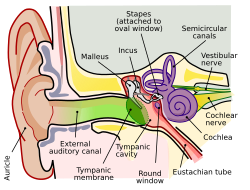Outer ear
This article has multiple issues. Please help improve it or discuss these issues on the talk page. (Learn how and when to remove these template messages)
|
| Outer ear | |
|---|---|
 A diagram of the anatomy of the human ear: Brown is outer ear.
Red is middle ear.
Purple is inner ear. | |
 The auricula. Lateral surface. | |
| Details | |
| Identifiers | |
| Latin | auris externa |
| MeSH | D004431 |
| NeuroLex ID | birnlex_1705 |
| TA98 | A15.3.01.001 |
| TA2 | 6862 |
| FMA | 52781 |
| Anatomical terminology | |
 |
| This article is one of a series documenting the anatomy of the |
| Human ear |
|---|
The outer ear, external ear, or auris externa is the external part of the
Structure
Auricle
The visible part is called the
Ear canal
From the pinna, the
Auricular muscles
Intrinsic muscles
| Intrinsic muscles of external ear | |
|---|---|
auricula | |
| Details | |
| Nerve | Facial nerve |
| Actions | Undeveloped in humans |
| Identifiers | |
| MeSH | D004431 |
| NeuroLex ID | birnlex_1705 |
| TA98 | A15.3.01.001 |
| TA2 | 6862 |
| FMA | 52781 |
| Anatomical terms of muscle] | |
The intrinsic auricular muscles are:
- The helicis major is a narrow vertical band situated upon the anterior margin of the helix. It arises below, from the spina helicis, and is inserted into the anterior border of the helix, just where it is about to curve backward.
- The helicis minor is an oblique fasciculus, covering the crus helicis.
- The tragicus is a short, flattened vertical band on the lateral surface of the tragus. Also known as the mini lobe.
- The antitragicus arises from the outer part of the antitragus, and is inserted into the cauda helicis and antihelix.
- The scapha.
- The conchato the convexity immediately above it.
The intrinsic muscles contribute to the topography of the auricle, while also function as a sphincter of the external auditory meatus. It has been suggested that during prenatal development in the womb, these muscles exert forces on the cartilage which in turn affects the shaping of the ear.[3]
Extrinsic muscles
| Auricular muscles | |
|---|---|
pinna | |
| Artery | Posterior auricular artery |
| Nerve | Facial nerve |
| Actions | Subtle auricle movements (forwards, backwards and upwards) |
| Identifiers | |
| Latin | musculi auriculares |
| MeSH | D004431 |
| NeuroLex ID | birnlex_1705 |
| TA98 | A15.3.01.001 |
| TA2 | 6862 |
| FMA | 52781 |
| Anatomical terms of muscle] | |
The extrinsic auricular muscles are the three
The superior muscle is the largest of the three, followed by the posterior and the anterior.
In some mammals these muscles can adjust the direction of the pinna. In humans these muscles possess very little action. The auricularis anterior draws the auricula forward and upward, the auricularis superior slightly raises it, and the auricularis posterior draws it backward. The superior auricular muscle also acts as a stabilizer of the occipitofrontalis muscle and as a weak brow lifter.[4] The presence of auriculomotor activity in the posterior auricular muscle causes the muscle to contract and cause the pinna to be pulled backwards and flatten when exposed to sudden, surprising sounds.[5]
Function
This section needs expansion. You can help by adding to it. (December 2013) |
One consequence of the configuration of the outer ear is selectively to boost the sound pressure 30- to 100-fold for frequencies around 3 kHz. This amplification makes humans most sensitive to frequencies in this range—and also explains why they are particularly prone to acoustical injury and hearing loss near this frequency. Most human speech sounds are also distributed in the bandwidth around 3 kHz.[6]
Clinical significance
Malformations of the external ear can be a consequence of
. Such defects include:- A autosomal recessive fashion and may suffer from chronic infection in later life.[7]
- Cosmetic defects, such as very large ears, small ears.[8][9]
- Malformation that may lead to functional impairment, such as atresia of the external auditory meatus[10] or aplasia of the pinna,[11]
- Genetic syndromes, which include:
Surgery
Usually, malformations are treated with surgery, although artificial prostheses are also sometimes used.[9]
- Preauricular fistulas are generally not treated unless chronically inflamed.[9]
- Cosmetic defects without functional impairment are generally repaired after ages 6–7.[17]
If malformations are accompanied by hearing loss amenable to correction, then the early use of hearing aids may prevent complete hearing loss.[17]
Additional images
-
External and middle ear, opened from the front. Right side.
References
![]() This article incorporates text in the public domain from page 1033 of the 20th edition of Gray's Anatomy (1918)
This article incorporates text in the public domain from page 1033 of the 20th edition of Gray's Anatomy (1918)
- ^ nyu.edu/classes/bello/FMT_files/2_hearing.pdf "Hearing" by Juan P Bello
- ^ "Why Can Some People Wiggle Their Ears?". Live Science. 30 March 2012.
- PMID 29387041.
- S2CID 227236615.
- PMID 32618268.
- ISBN 978-0-87893-697-7.)
{{cite book}}: CS1 maint: multiple names: authors list (link - ^ Богомильский, Чистякова 2002, pp. 68–69.
- ^ Богомильский, Чистякова 2002, pp. 65–66.
- ^ a b c Пальчун, Крюков 2001, p. 489.
- ^ СЭС 1986, p. 89.
- ^ СЭС 1986, p. 68.
- ^ Богомильский, Чистякова 2002, pp. 66–67.
- ^ Богомильский, Чистякова 2002, p. 67.
- ^ Богомильский, Чистякова 2002, pp. 67–68.
- ^ Асанов и др. 2003, pp. 198–199.
- ^ Асанов и др. 2003, p. 198.
- ^ a b Богомильский, Чистякова 2002, p. 65.
External links
![]() Media related to Outer ear at Wikimedia Commons
Media related to Outer ear at Wikimedia Commons

